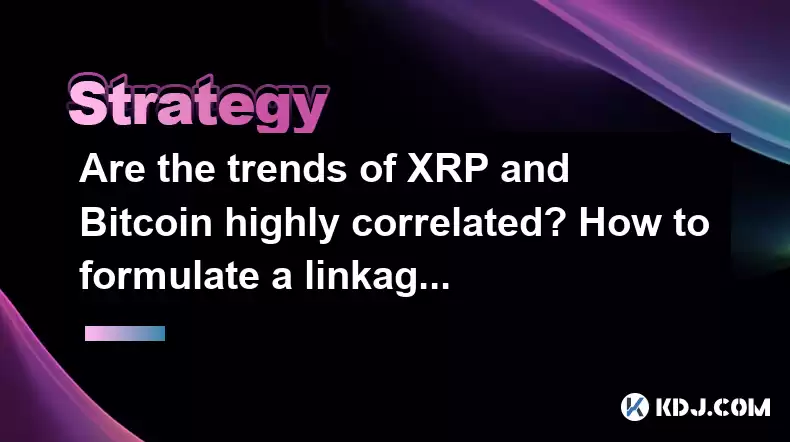-
 bitcoin
bitcoin $122659.385674 USD
0.52% -
 ethereum
ethereum $4484.113342 USD
-0.09% -
 bnb
bnb $1304.229256 USD
-0.85% -
 tether
tether $1.000204 USD
-0.03% -
 xrp
xrp $2.860636 USD
-0.51% -
 solana
solana $227.288799 USD
2.36% -
 usd-coin
usd-coin $0.999805 USD
0.01% -
 dogecoin
dogecoin $0.252837 USD
1.18% -
 tron
tron $0.341149 USD
1.12% -
 cardano
cardano $0.830507 USD
0.33% -
 hyperliquid
hyperliquid $45.792319 USD
0.04% -
 chainlink
chainlink $22.422164 USD
1.55% -
 ethena-usde
ethena-usde $1.000283 USD
0.01% -
 sui
sui $3.511389 USD
0.83% -
 stellar
stellar $0.385276 USD
-0.44%
Are the trends of XRP and Bitcoin highly correlated? How to formulate a linkage trading strategy
XRP and Bitcoin's correlation can guide trading strategies; high correlation might prompt buying XRP when Bitcoin shows bullish trends.
May 04, 2025 at 05:28 pm

The relationship between XRP and Bitcoin is a topic of great interest within the cryptocurrency community, particularly when it comes to trading strategies. Understanding whether the trends of XRP and Bitcoin are highly correlated can provide valuable insights for traders looking to capitalize on market movements. This article will delve into the correlation between XRP and Bitcoin, explore the factors influencing this correlation, and provide a detailed guide on how to formulate a linkage trading strategy based on these insights.
Understanding Correlation in Cryptocurrency Markets
Correlation in the context of financial markets, including cryptocurrencies, refers to the statistical measure of how two assets move in relation to each other. A high positive correlation means that the assets tend to move in the same direction, while a high negative correlation indicates they move in opposite directions. For XRP and Bitcoin, understanding their correlation can help traders predict potential movements in one asset based on the movements of the other.
To determine the correlation between XRP and Bitcoin, traders often use correlation coefficients, which range from -1 to +1. A coefficient close to +1 indicates a strong positive correlation, while a coefficient close to -1 indicates a strong negative correlation. A coefficient around 0 suggests little to no correlation.
Historical Data Analysis of XRP and Bitcoin
Analyzing historical data is crucial for understanding the correlation between XRP and Bitcoin. Historical price data can be sourced from various cryptocurrency data providers such as CoinMarketCap, CoinGecko, or directly from exchange APIs. By plotting the daily, weekly, or monthly returns of both XRP and Bitcoin over a significant period, traders can visually and statistically assess their correlation.
For instance, if the historical data shows that XRP and Bitcoin often move in tandem during certain market conditions, this could indicate a high positive correlation. Conversely, if XRP tends to move independently of Bitcoin's movements, the correlation might be low or even negative.
Factors Influencing the Correlation Between XRP and Bitcoin
Several factors can influence the correlation between XRP and Bitcoin. Market sentiment plays a significant role; during bullish market conditions, both assets may rise together due to increased investor confidence in cryptocurrencies as a whole. Conversely, during bearish conditions, both may decline as investors pull out of the market.
Regulatory news can also impact the correlation. For example, if there is a significant regulatory development affecting XRP, such as the ongoing SEC lawsuit against Ripple, this may cause XRP to decouple from Bitcoin's movements temporarily.
Technological developments within the respective ecosystems can also affect correlation. For instance, if there are significant updates or partnerships announced for XRP's RippleNet, this might influence XRP's price independently of Bitcoin.
Formulating a Linkage Trading Strategy
A linkage trading strategy involves using the correlation between XRP and Bitcoin to make trading decisions. Here is a step-by-step guide to formulating such a strategy:
- Gather Data: Collect historical price data for both XRP and Bitcoin over a suitable timeframe. This data can be obtained from cryptocurrency data platforms or exchange APIs.
- Calculate Correlation: Use statistical tools or software to calculate the correlation coefficient between XRP and Bitcoin. This can be done using platforms like Excel, Python with libraries such as Pandas and NumPy, or specialized financial analysis software.
- Analyze Trends: Examine the historical trends to identify periods of high and low correlation. Look for patterns that might indicate when XRP and Bitcoin are likely to move together or independently.
- Develop Trading Rules: Based on your analysis, develop specific trading rules. For example, if the correlation is high, you might decide to buy XRP when Bitcoin shows signs of a bullish trend, and vice versa.
- Backtest the Strategy: Use historical data to backtest your trading rules. This involves simulating trades based on your strategy to see how it would have performed in the past. This step is crucial for validating the effectiveness of your strategy.
- Implement and Monitor: Once you are satisfied with your backtesting results, implement the strategy in real-time trading. Continuously monitor the performance and adjust the strategy as necessary based on new data and market conditions.
Practical Example of a Linkage Trading Strategy
To illustrate how a linkage trading strategy might work, consider the following hypothetical scenario:
- High Correlation Period: You observe that during a specific period, the correlation coefficient between XRP and Bitcoin is around +0.8. This indicates a strong positive correlation.
- Trading Rule: You decide to buy XRP whenever Bitcoin shows a bullish signal, such as breaking above a significant resistance level.
- Execution: You monitor Bitcoin's price and notice it breaks above a key resistance level. Based on your trading rule, you buy XRP.
- Monitoring: You keep an eye on both XRP and Bitcoin's movements. If the correlation remains high, you might hold onto XRP until Bitcoin shows signs of a bearish reversal.
Tools and Resources for Implementing a Linkage Trading Strategy
To effectively implement a linkage trading strategy, traders need access to the right tools and resources. Cryptocurrency exchanges such as Binance, Coinbase, or Kraken are essential for executing trades. Trading platforms like TradingView or MetaTrader can provide advanced charting and analysis capabilities.
Data analysis tools such as Python with libraries like Pandas, NumPy, and Matplotlib can help in calculating correlation coefficients and backtesting strategies. APIs from exchanges and data providers can be used to automate data collection and strategy execution.
Risks and Considerations in Linkage Trading
While a linkage trading strategy can be effective, it is not without risks. Market volatility can lead to sudden changes in correlation, making it challenging to predict movements accurately. Over-reliance on historical data can also be problematic if market conditions change significantly.
Diversification is crucial to mitigate risks. Traders should not put all their capital into a single strategy but should diversify across different assets and strategies. Risk management practices, such as setting stop-loss orders and managing position sizes, are essential to protect against potential losses.
Frequently Asked Questions
Q1: Can the correlation between XRP and Bitcoin change over time?Yes, the correlation between XRP and Bitcoin can change over time due to various factors such as market sentiment, regulatory news, and technological developments. Traders need to continuously monitor and adjust their strategies based on these changes.
Q2: Is it possible to automate a linkage trading strategy?Yes, it is possible to automate a linkage trading strategy using programming languages like Python. By integrating with exchange APIs and using libraries for data analysis and strategy execution, traders can automate the process of collecting data, calculating correlations, and executing trades based on predefined rules.
Q3: How often should I reassess the correlation between XRP and Bitcoin?It is advisable to reassess the correlation between XRP and Bitcoin at least monthly, if not more frequently, depending on market conditions. Rapid changes in the market can affect correlation, so staying updated is crucial for maintaining an effective trading strategy.
Q4: Are there other cryptocurrencies that can be included in a linkage trading strategy with XRP and Bitcoin?Yes, other cryptocurrencies such as Ethereum, Litecoin, or Cardano can be included in a linkage trading strategy. The key is to analyze the correlation between these assets and XRP and Bitcoin to develop a comprehensive trading approach.
Disclaimer:info@kdj.com
The information provided is not trading advice. kdj.com does not assume any responsibility for any investments made based on the information provided in this article. Cryptocurrencies are highly volatile and it is highly recommended that you invest with caution after thorough research!
If you believe that the content used on this website infringes your copyright, please contact us immediately (info@kdj.com) and we will delete it promptly.
- Coin, 2025, Bull Run: What's the Hype?
- 2025-10-10 04:45:14
- Bluey Ballot Bonanza: Real Life Coin Tips from Down Under!
- 2025-10-10 05:05:13
- Toncoin (TON) Price Analysis: Crash or Correction? What's a New Yorker to Do?
- 2025-10-10 04:45:14
- Bluey Ballot Bonanza: Real Life Coin Tips from Down Under!
- 2025-10-10 04:50:01
- HBAR, SHIB, BlockDAG: Crypto's Fast Lane to 2025 and Beyond
- 2025-10-10 05:05:13
- Worldcoin (WLD): Navigating the Accumulation Zone Like a Pro
- 2025-10-10 05:10:00
Related knowledge

Practical parameter settings for a Bitcoin multi-timeframe moving average system
Sep 18,2025 at 10:54pm
Optimizing Timeframe Combinations for Bitcoin Trading1. Selecting appropriate timeframes is crucial when building a multi-timeframe moving average sys...

How can I filter out false breakouts in Dogecoin high-frequency trading?
Sep 22,2025 at 01:00am
Understanding False Breakouts in Dogecoin Trading1. A false breakout occurs when Dogecoin's price appears to move beyond a defined support or resistan...

Techniques for identifying tops and bottoms in the Bitcoin on-chain NVT model
Sep 20,2025 at 07:54pm
Understanding the NVT Model in Bitcoin Analysis1. The Network Value to Transactions (NVT) ratio is often described as the 'P/E ratio' of the cryptocur...

What does the surge in open interest in Bitcoincoin futures mean?
Sep 20,2025 at 11:18pm
Understanding the Surge in Dogecoin Futures Open Interest1. A surge in open interest within Dogecoin futures indicates a growing number of active cont...

How can I use the Ethereum USDT premium to gauge market sentiment?
Sep 18,2025 at 11:55pm
Understanding the Ethereum USDT Premium1. The Ethereum USDT premium refers to the price difference between USDT (Tether) traded on Ethereum-based plat...

What should I do if Ethereum staking yields decline?
Sep 20,2025 at 06:18am
Understanding the Causes Behind Declining Ethereum Staking Yields1. The Ethereum network transitioned to a proof-of-stake consensus mechanism with the...

Practical parameter settings for a Bitcoin multi-timeframe moving average system
Sep 18,2025 at 10:54pm
Optimizing Timeframe Combinations for Bitcoin Trading1. Selecting appropriate timeframes is crucial when building a multi-timeframe moving average sys...

How can I filter out false breakouts in Dogecoin high-frequency trading?
Sep 22,2025 at 01:00am
Understanding False Breakouts in Dogecoin Trading1. A false breakout occurs when Dogecoin's price appears to move beyond a defined support or resistan...

Techniques for identifying tops and bottoms in the Bitcoin on-chain NVT model
Sep 20,2025 at 07:54pm
Understanding the NVT Model in Bitcoin Analysis1. The Network Value to Transactions (NVT) ratio is often described as the 'P/E ratio' of the cryptocur...

What does the surge in open interest in Bitcoincoin futures mean?
Sep 20,2025 at 11:18pm
Understanding the Surge in Dogecoin Futures Open Interest1. A surge in open interest within Dogecoin futures indicates a growing number of active cont...

How can I use the Ethereum USDT premium to gauge market sentiment?
Sep 18,2025 at 11:55pm
Understanding the Ethereum USDT Premium1. The Ethereum USDT premium refers to the price difference between USDT (Tether) traded on Ethereum-based plat...

What should I do if Ethereum staking yields decline?
Sep 20,2025 at 06:18am
Understanding the Causes Behind Declining Ethereum Staking Yields1. The Ethereum network transitioned to a proof-of-stake consensus mechanism with the...
See all articles


























![🚨IS VECHAIN (VET) A DEAD COIN ?? PRICE ANALYSIS [GET READY NOW] 🚨IS VECHAIN (VET) A DEAD COIN ?? PRICE ANALYSIS [GET READY NOW]](/uploads/2025/10/09/cryptocurrencies-news/videos/vechain-vet-dead-coin-price-analysis-ready/68e7b200b067b_image_500_375.webp)















































